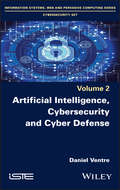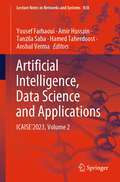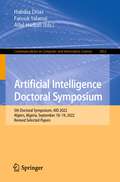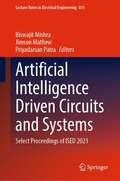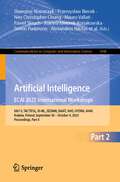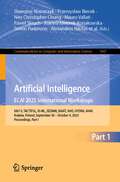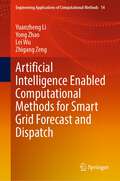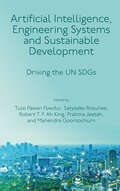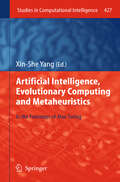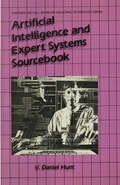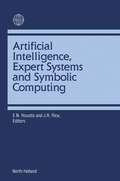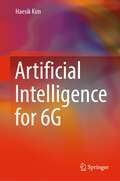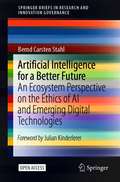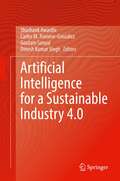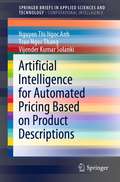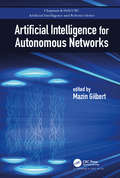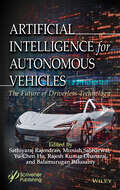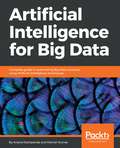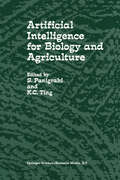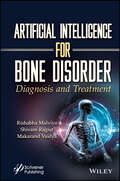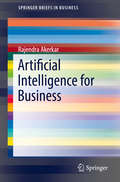- Table View
- List View
Artificial Intelligence, Cybersecurity and Cyber Defence
by Daniel VentreThe aim of the book is to analyse and understand the impacts of artificial intelligence in the fields of national security and defense; to identify the political, geopolitical, strategic issues of AI; to analyse its place in conflicts and cyberconflicts, and more generally in the various forms of violence; to explain the appropriation of artificial intelligence by military organizations, but also law enforcement agencies and the police; to discuss the questions that the development of artificial intelligence and its use raise in armies, police, intelligence agencies, at the tactical, operational and strategic levels.
Artificial Intelligence, Data Science and Applications: ICAISE’2023, Volume 2 (Lecture Notes in Networks and Systems #838)
by Yousef Farhaoui Amir Hussain Tanzila Saba Hamed Taherdoost Anshul VermaThis book is to provide a comprehensive reference for professionals in the field of data science and applications: artificial intelligence, big data, IoT, and blockchain. In summary, this book is expected to function as a helpful resource and manual, enabling readers to navigate the intricate domain of artificial intelligence, the Internet of things (IoT), and blockchain in smart environments. This book covers many topics related to integrating AI, IoT, blockchain, and smart environments. It begins by laying a solid foundation, introducing each technology's fundamental concepts and principles. Subsequent chapters explore applications and real-world use cases, demonstrating how AI, IoT, and blockchain can effectively address critical challenges within data science and applications.
Artificial Intelligence Doctoral Symposium: 5th Doctoral Symposium, AID 2022, Algiers, Algeria, September 18–19, 2022, Revised Selected Papers (Communications in Computer and Information Science #1852)
by Habiba Drias Farouk Yalaoui Allel HadjaliThis volume constitutes selected papers presented during the 5th Artificial Intelligence Doctoral Symposium, AID 2022, held in Algiers, Algeria, in September 2022. The 22 presented full papers were thoroughly reviewed and selected from the 38 qualified submissions. They are organized in the following topical sections: data mining; metaheuristics and swarm intelligence; computer vision; Artificial Intelligence applications; machine and deep learning; NLP and text mining.
Artificial Intelligence Driven Circuits and Systems: Select Proceedings of ISED 2021 (Lecture Notes in Electrical Engineering #811)
by Biswajit Mishra Jimson Mathew Priyadarsan PatraThis book highlights selected papers presented at the 10th International Symposium on Embedded Computing and System Design (ISED) 2021. This symposium provides a platform for researchers to share the latest scientific achievements of embedded computing and system design. The book is divided into three broad sections. The first section discusses topics like VLSI and testing, circuits and systems with a focus on emerging technologies. The second section discusses topics like embedded hardware and software systems and novel applications. The final section discusses the state-of-the-art technologies involving IoT, artificial intelligence, green and edge computing that demonstrates the issues currently.
Artificial Intelligence. ECAI 2023 International Workshops: XAI^3, TACTIFUL, XI-ML, SEDAMI, RAAIT, AI4S, HYDRA, AI4AI, Kraków, Poland, September 30 – October 4, 2023, Proceedings, Part II (Communications in Computer and Information Science #1948)
by Sławomir Nowaczyk Przemysław Biecek Neo Christopher Chung Mauro Vallati Paweł Skruch Joanna Jaworek-Korjakowska Simon Parkinson Alexandros Nikitas Martin Atzmüller Tomáš Kliegr Ute Schmid Szymon Bobek Nada Lavrac Marieke Peeters Roland Van Dierendonck Saskia Robben Eunika Mercier-Laurent Gülgün Kayakutlu Mieczyslaw Lech Owoc Karl Mason Abdul Wahid Pierangela Bruno Francesco Calimeri Francesco Cauteruccio Giorgio Terracina Diedrich Wolter Jochen L. Leidner Michael Kohlhase Vania DimitrovaThis volume constitutes the refereed proceedings presented at the international workshops of the 26th European Conference on Artificial Intelligence, ECAI 2023, which was held in Kraków, Poland, in September-October 2023. The papers in this volume were presented at the following workshops: XAI^3, TACTIFUL, XI-ML, SEDAMI, RAAIT, AI4S, HYDRA, AI4AI.
Artificial Intelligence. ECAI 2023 International Workshops: XAI^3, TACTIFUL, XI-ML, SEDAMI, RAAIT, AI4S, HYDRA, AI4AI, Kraków, Poland, September 30 – October 4, 2023, Proceedings, Part I (Communications in Computer and Information Science #1947)
by Sławomir Nowaczyk Przemysław Biecek Neo Christopher Chung Mauro Vallati Paweł Skruch Joanna Jaworek-Korjakowska Simon Parkinson Alexandros Nikitas Martin Atzmüller Tomáš Kliegr Ute Schmid Szymon Bobek Nada Lavrac Marieke Peeters Roland Van Dierendonck Saskia Robben Eunika Mercier-Laurent Gülgün Kayakutlu Mieczyslaw Lech Owoc Karl Mason Abdul Wahid Pierangela Bruno Francesco Calimeri Francesco Cauteruccio Giorgio Terracina Diedrich Wolter Jochen L. Leidner Michael Kohlhase Vania DimitrovaThis volume constitutes the refereed proceedings presented at the international workshops of the 26th European Conference on Artificial Intelligence, ECAI 2023, which was held in Kraków, Poland, in September-October 2023. The papers in this volume were presented at the following workshops: XAI^3, TACTIFUL, XI-ML, SEDAMI, RAAIT, AI4S, HYDRA, AI4AI.
Artificial Intelligence Enabled Computational Methods for Smart Grid Forecast and Dispatch (Engineering Applications of Computational Methods #14)
by Yuanzheng Li Yong Zhao Lei Wu Zhigang ZengWith the increasing penetration of renewable energy and distributed energy resources, smart grid is facing great challenges, which could be divided into two categories. On the one hand, the endogenous uncertainties of renewable energy and electricity load lead to great difficulties in smart grid forecast. On the other hand, massive electric devices as well as their complex constraint relationships bring about significant difficulties in smart grid dispatch. Owe to the rapid development of artificial intelligence in recent years, several artificial intelligence enabled computational methods have been successfully applied in the smart grid and achieved good performances. Therefore, this book is concerned with the research on the key issues of artificial intelligence enabled computational methods for smart grid forecast and dispatch, which consist of three main parts. (1) Introduction for smart grid forecast and dispatch, in inclusion of reviewing previous contribution of various research methods as well as their drawbacks to analyze characteristics of smart grid forecast and dispatch.(2) Artificial intelligence enabled computational methods for smart grid forecast problems, which are devoted to present the recent approaches of deep learning and machine learning as well as their successful applications in smart grid forecast.(3) Artificial intelligence enabled computational methods for smart grid dispatch problems, consisting of edge-cutting intelligent decision-making approaches, which help determine the optimal solution of smart grid dispatch. The book is useful for university researchers, engineers, and graduate students in electrical engineering and computer science who wish to learn the core principles, methods, algorithms, and applications of artificial intelligence enabled computational methods.
Artificial Intelligence, Engineering Systems and Sustainable Development: Driving the UN SDGs
by Tulsi Pawan Fowdur Satyadev Rosunee Robert T. F. Ah King Pratima Jeetah Mahendra GooroochurnDevelopment in any country is impossible if reliable and affordable energy, safe water and sanitation, as well as telecommunication facilities, are not easily accessible. Artificial intelligence and machine learning techniques are now widely used in all branches of engineering to build and optimize systems. The combination of AI and engineering can indeed act as a real catalyst to achieve the UN SDGs. The volume editors present an analysis of different concepts and case studies in engineering disciplines such as chemical, civil, electrical, telecommunications and mechanical engineering, demonstrating how engineering systems and processes can leverage the power of AI to drive and achieve the UN SDGs. Topics covered include sustainable crop production and consumption, AI based clean water and sanitation monitoring, intelligent transport systems and achieving affordable and clean energy through AI and 5G powered internet of energy. Such a study is of paramount importance and is a valuable source of information for researchers, engineers, and policy makers to be able to better design and adopt AI enabled techniques in different engineering areas, with a view to catalyze the achievement of the UN SDGs.
Artificial Intelligence, Engineering Systems and Sustainable Development: Driving the UN SDGs
by Tulsi Pawan Fowdur, Satyadev Rosunee, Robert T. F. Ah King, Pratima Jeetah and Mahendra GooroochurnDevelopment in any country is impossible if reliable and affordable energy, safe water and sanitation, as well as telecommunication facilities, are not easily accessible. Artificial intelligence and machine learning techniques are now widely used in all branches of engineering to build and optimize systems. The combination of AI and engineering can indeed act as a real catalyst to achieve the UN SDGs. The volume editors present an analysis of different concepts and case studies in engineering disciplines such as chemical, civil, electrical, telecommunications and mechanical engineering, demonstrating how engineering systems and processes can leverage the power of AI to drive and achieve the UN SDGs. Topics covered include sustainable crop production and consumption, AI based clean water and sanitation monitoring, intelligent transport systems and achieving affordable and clean energy through AI and 5G powered internet of energy. Such a study is of paramount importance and is a valuable source of information for researchers, engineers, and policy makers to be able to better design and adopt AI enabled techniques in different engineering areas, with a view to catalyze the achievement of the UN SDGs.
Artificial Intelligence, Evolutionary Computing and Metaheuristics: In the Footsteps of Alan Turing (Studies in Computational Intelligence #427)
by Xin-She YangAlan Turing pioneered many research areas such as artificial intelligence, computability, heuristics and pattern formation. Nowadays at the information age, it is hard to imagine how the world would be without computers and the Internet. Without Turing's work, especially the core concept of Turing Machine at the heart of every computer, mobile phone and microchip today, so many things on which we are so dependent would be impossible.2012 is the Alan Turing year -- a centenary celebration of the life and work of Alan Turing. To celebrate Turing's legacy and follow the footsteps of this brilliant mind, we take this golden opportunity to review the latest developments in areas of artificial intelligence, evolutionary computation and metaheuristics, and all these areas can be traced back to Turing's pioneer work. Topics include Turing test, Turing machine, artificial intelligence, cryptography, software testing, image processing, neural networks, nature-inspired algorithms such as bat algorithm and cuckoo search, and multiobjective optimization and many applications. These reviews and chapters not only provide a timely snapshot of the state-of-art developments, but also provide inspiration for young researchers to carry out potentially ground-breaking research in the active, diverse research areas in artificial intelligence, cryptography, machine learning, evolutionary computation, and nature-inspired metaheuristics. This edited book can serve as a timely reference for graduates, researchers and engineers in artificial intelligence, computer sciences, computational intelligence, soft computing, optimization, and applied sciences.
Artificial Intelligence & Expert Systems Sourcebook (Chapman And Hall Advanced Industrial Technology Ser.)
by V. Daniel HuntArtificial Intelligence and expert systems research, development, and demonstration have rapidly expanded over the past several years; as a result, new terminology is appearing at a phenomenal rate. This sourcebook provides an introduction to artificial intelligence and expert systems, it provides brief definitions, it includes brief descriptions of software products, and vendors, and notes leaders in the field. Extensive support material is provided by delineating points of contact for receiving additional information, acronyms, a detailed bibliography, and other reference data. The terminology includes artificial intelligence and expert system elements for: • Artificial Intelligence • Expert Systems • Natural language Processing • Smart Robots • Machine Vision • Speech Synthesis The Artificial Intelligence and Expert System Sourcebook is compiled from informa tion acquired from numerous books, journals, and authorities in the field of artificial intelligence and expert systems. I hope this compilation of information will help clarify the terminology for artificial intelligence and expert systems' activities. Your comments, revisions, or questions are welcome. V. Daniel Hunt Springfield, Virginia May, 1986 ix Acknowledgments The information in Artificial Intelligence and Expert Systems Sourcebook has been compiled from a wide variety of authorities who are specialists in their respective fields. The following publications were used as the basic technical resources for this book. Portions of these publications may have been used in the book. Those definitions or artwork used have been reproduced with the permission to reprint of the respective publisher.
Artificial Intelligence, Expert Systems & Symbolic Computing
by E. N. Houstis J. R. RiceThis volume contains papers in the areas of artificial intelligence, expert systems, symbolic computing and applications to scientific computing. Together, they provide an excellent overview of the dynamic state of these closely related fields. They reveal a future where scientific computation will increasingly involve symbolic and artificial intelligence tools as these software systems become more sophisticated; also a future where systems of computational science and engineering will be problem solving environments created with components from numerical analysis, computational geometry, symbolic computing and artificial intelligence.
Artificial Intelligence for 6G
by Haesik KimThis textbook introduces Artificial Intelligence (AI) techniques for wireless communications and networks, helping readers to find solutions for communications and network problems using AI. Artificial Intelligence for 6G introduces, in a step-by-step manner, AI techniques such as: unsupervised learning;supervised learning;reinforcement learning; anddeep learning. It explains how these techniques can be used for wireless communications and network systems, particularly in designing and optimizing 6G networks. This book is at the forefront of 6G research, and will be of interest internationally, to graduate students, academics, engineers, and developers who are focused on future development of network systems and mobile communications.
Artificial Intelligence for a Better Future: An Ecosystem Perspective on the Ethics of AI and Emerging Digital Technologies (SpringerBriefs in Research and Innovation Governance)
by Bernd Carsten StahlThis open access book proposes a novel approach to Artificial Intelligence (AI) ethics. AI offers many advantages: better and faster medical diagnoses, improved business processes and efficiency, and the automation of boring work. But undesirable and ethically problematic consequences are possible too: biases and discrimination, breaches of privacy and security, and societal distortions such as unemployment, economic exploitation and weakened democratic processes. There is even a prospect, ultimately, of super-intelligent machines replacing humans. The key question, then, is: how can we benefit from AI while addressing its ethical problems?This book presents an innovative answer to the question by presenting a different perspective on AI and its ethical consequences. Instead of looking at individual AI techniques, applications or ethical issues, we can understand AI as a system of ecosystems, consisting of numerous interdependent technologies, applications and stakeholders. Developing this idea, the book explores how AI ecosystems can be shaped to foster human flourishing. Drawing on rich empirical insights and detailed conceptual analysis, it suggests practical measures to ensure that AI is used to make the world a better place.
Artificial Intelligence for a Sustainable Industry 4.0
by Shashank Awasthi Carlos M. Travieso-González Goutam Sanyal Dinesh Kumar SinghThis book outlines the recent advancements in the field of artificial intelligence (AI) and addresses how useful it is in achieving truly sustainable solutions. The book also serves as a useful reference literature in developing sustainable engineering solutions to various social and techno-commercial issues of global significance. This book is organized into two sections: section 1 is focused on fundamentals and principles of AI to lay the groundwork for the second section. Section 2 explores the sustainable engineering solutions development using AI, which addresses challenges in various computing techniques and opportunities in engineering design for sustainable development using IoT/AI and smart cities. Applications include waste minimization, re-manufacturing, reuse and recycling technologies using IoT/AI, Industry 4.0, intelligent and smart grid systems, energy conservation using technology, and robotic process automation (RPA). The book is ideal for the engineers, researchers and students interested in how AI can aid in sustainable development applications.
Artificial Intelligence for Automated Pricing Based on Product Descriptions (SpringerBriefs in Applied Sciences and Technology)
by Nguyen Thi Anh Tran Ngoc Thang Vijender Kumar SolankiThis book highlights artificial intelligence algorithms used in implementation of automated pricing. It presents the process for building automated pricing models from crawl data, preprocessed data to implement models, and their applications. The book also focuses on machine learning and deep learning methods for pricing, including from regression methods to hybrid and ensemble methods. The computational experiments are presented to illustrate the pricing processes and models.
Artificial Intelligence for Autonomous Networks (Chapman & Hall/CRC Artificial Intelligence and Robotics Series)
by Mazin GilbertArtificial Intelligence for Autonomous Networks introduces the autonomous network by juxtaposing two unique technologies and communities: Networking and AI. The book reviews the technologies behind AI and software-defined network/network function virtualization, highlighting the exciting opportunities to integrate those two worlds. Outlining the new frontiers for autonomous networks, this book highlights their impact and benefits to consumers and enterprise customers. It also explores the potential of the autonomous network for transforming network operation, cyber security, enterprise services, 5G and IoT, infrastructure monitoring and traffic optimization, and finally, customer experience and care. With contributions from leading experts, this book will provide an invaluable resource for network engineers, software engineers, artificial intelligence, and machine learning researchers.
Artificial Intelligence for Autonomous Networks (Chapman & Hall/CRC Artificial Intelligence and Robotics Series)
by Mazin GilbertArtificial Intelligence for Autonomous Networks introduces the autonomous network by juxtaposing two unique technologies and communities: Networking and AI. The book reviews the technologies behind AI and software-defined network/network function virtualization, highlighting the exciting opportunities to integrate those two worlds. Outlining the new frontiers for autonomous networks, this book highlights their impact and benefits to consumers and enterprise customers. It also explores the potential of the autonomous network for transforming network operation, cyber security, enterprise services, 5G and IoT, infrastructure monitoring and traffic optimization, and finally, customer experience and care. With contributions from leading experts, this book will provide an invaluable resource for network engineers, software engineers, artificial intelligence, and machine learning researchers.
Artificial Intelligence for Autonomous Vehicles: The Future of Driverless Technology (Advances in Data Engineering and Machine Learning)
by Sathiyaraj Rajendran Munish Sabharwal Yu-Chen Hu Rajesh Kumar Dhanaraj Balamurugan BalusamyWith the advent of advanced technologies in AI, driverless vehicles have elevated curiosity among various sectors of society. The automotive industry is in a technological boom with autonomous vehicle concepts. Autonomous driving is one of the crucial application areas of Artificial Intelligence (AI). Autonomous vehicles are armed with sensors, radars, and cameras. This made driverless technology possible in many parts of the world. In short, our traditional vehicle driving may swing to driverless technology. Many researchers are trying to come out with novel AI algorithms that are capable of handling driverless technology. The current existing algorithms are not able to support and elevate the concept of autonomous vehicles. This addresses the necessity of novel methods and tools focused to design and develop frameworks for autonomous vehicles. There is a great demand for energy-efficient solutions for managing the data collected with the help of sensors. These operations are exclusively focused on non-traditional programming approaches and depend on machine learning techniques, which are part of AI. There are multiple issues that AI needs to resolve for us to achieve a reliable and safe driverless technology. The purpose of this book is to find effective solutions to make autonomous vehicles a reality, presenting their challenges and endeavors. The major contribution of this book is to provide a bundle of AI solutions for driverless technology that can offer a safe, clean, and more convenient riskless mode of transportation.
Artificial Intelligence for Autonomous Vehicles: The Future of Driverless Technology (Advances in Data Engineering and Machine Learning)
by Sathiyaraj Rajendran Munish Sabharwal Yu-Chen Hu Rajesh Kumar Dhanaraj Balamurugan BalusamyWith the advent of advanced technologies in AI, driverless vehicles have elevated curiosity among various sectors of society. The automotive industry is in a technological boom with autonomous vehicle concepts. Autonomous driving is one of the crucial application areas of Artificial Intelligence (AI). Autonomous vehicles are armed with sensors, radars, and cameras. This made driverless technology possible in many parts of the world. In short, our traditional vehicle driving may swing to driverless technology. Many researchers are trying to come out with novel AI algorithms that are capable of handling driverless technology. The current existing algorithms are not able to support and elevate the concept of autonomous vehicles. This addresses the necessity of novel methods and tools focused to design and develop frameworks for autonomous vehicles. There is a great demand for energy-efficient solutions for managing the data collected with the help of sensors. These operations are exclusively focused on non-traditional programming approaches and depend on machine learning techniques, which are part of AI. There are multiple issues that AI needs to resolve for us to achieve a reliable and safe driverless technology. The purpose of this book is to find effective solutions to make autonomous vehicles a reality, presenting their challenges and endeavors. The major contribution of this book is to provide a bundle of AI solutions for driverless technology that can offer a safe, clean, and more convenient riskless mode of transportation.
Artificial Intelligence for Big Data: Complete Guide To Automating Big Data Solutions Using Artificial Intelligence Techniques
by Anand DeshpandeCreate smart systems to extract intelligent insights for decision making. You will learn about widely used Artificial Intelligence techniques for carrying out solutions in a production-ready environment. You'll explore advanced topics such as clustering, symbolic and sub-symbolic information representation, and many more.
Artificial Intelligence for Bone Disorder: Diagnosis and Treatment
by Rishabha Malviya Shivam Rajput Makarand VaidyaARTIFICIAL INTELLIGENCE FOR BONE DISORDER The authors have produced an invaluable resource that connects the fields of AI and bone treatment by providing essential insights into the current state and future of AI in bone condition diagnosis and therapy, as well as a methodical examination of machine learning algorithms, deep learning approaches, and their real-world uses. The book explores the use of artificial intelligence (AI) in the diagnosis and treatment of various bone illnesses. The integration of AI approaches in the fields of orthopedics, radiography, tissue engineering, and other areas related to bone are discussed in detail. It covers tissue engineering methods for bone regeneration and investigates the use of AI tools in this area, emphasizing the value of deep learning and how to use AI in tissue engineering efficiently. The book also covers diagnostic and prognostic uses of AI in orthopedics, such as the diagnosis of disorders involving the hip and knee as well as prognoses for therapies. Chapters also look at MRI, trabecular biomechanical strength, and other methods for diagnosing osteoporosis. Other issues the book examines include several uses of AI in pediatric orthopedics, 3D modeling, digital X-ray radiogrammetry, convolutional neural networks for customized care, and digital tomography. With information on the most recent developments and potential future applications, each chapter of the book advances our understanding of how AI might be used to diagnose and treat bone problems. Audience This book will serve as a guide for orthopedic experts, biomedical engineers, faculty members, research scholars, IT specialists, healthcare workers, and hospital administrators.
Artificial Intelligence for Bone Disorder: Diagnosis and Treatment
by Rishabha Malviya Shivam Rajput Makarand VaidyaARTIFICIAL INTELLIGENCE FOR BONE DISORDER The authors have produced an invaluable resource that connects the fields of AI and bone treatment by providing essential insights into the current state and future of AI in bone condition diagnosis and therapy, as well as a methodical examination of machine learning algorithms, deep learning approaches, and their real-world uses. The book explores the use of artificial intelligence (AI) in the diagnosis and treatment of various bone illnesses. The integration of AI approaches in the fields of orthopedics, radiography, tissue engineering, and other areas related to bone are discussed in detail. It covers tissue engineering methods for bone regeneration and investigates the use of AI tools in this area, emphasizing the value of deep learning and how to use AI in tissue engineering efficiently. The book also covers diagnostic and prognostic uses of AI in orthopedics, such as the diagnosis of disorders involving the hip and knee as well as prognoses for therapies. Chapters also look at MRI, trabecular biomechanical strength, and other methods for diagnosing osteoporosis. Other issues the book examines include several uses of AI in pediatric orthopedics, 3D modeling, digital X-ray radiogrammetry, convolutional neural networks for customized care, and digital tomography. With information on the most recent developments and potential future applications, each chapter of the book advances our understanding of how AI might be used to diagnose and treat bone problems. Audience This book will serve as a guide for orthopedic experts, biomedical engineers, faculty members, research scholars, IT specialists, healthcare workers, and hospital administrators.
Artificial Intelligence for Business (SpringerBriefs in Business)
by Rajendra AkerkarThis book offers a practical guide to artificial intelligence (AI) techniques that are used in business. The book does not focus on AI models and algorithms, but instead provides an overview of the most popular and frequently used models in business. This allows the book to easily explain AI paradigms and concepts for business students and executives. Artificial Intelligence for Business is divided into six chapters. Chapter 1 begins with a brief introduction to AI and describes its relationship with machine learning, data science and big data analytics. Chapter 2 presents core machine learning workflow and the most effective machine learning techniques. Chapter 3 deals with deep learning, a popular technique for developing AI applications. Chapter 4 introduces recommendation engines for business and covers how to use them to be more competitive. Chapter 5 features natural language processing (NLP) for sentiment analysis focused on emotions. With the help of sentiment analysis, businesses can understand their customers better to improve their experience, which will help the businesses change their market position. Chapter 6 states potential business prospects of AI and the benefits that companies can realize by implementing AI in their processes.
